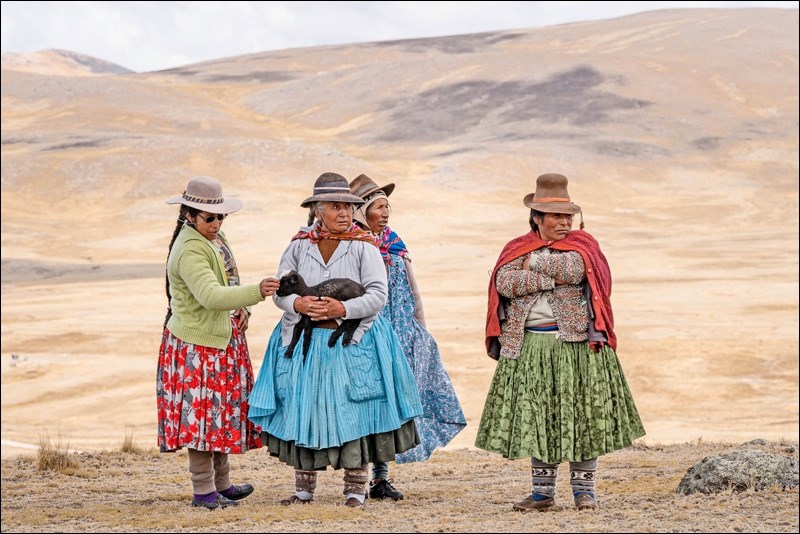The wind and the air were cold, but the sunshine on your face is so hot.
That was the first thing I noticed when Tayla and I arrived in Picotani, Peru, that is 16,000 feet above sea level. The landscape had no trees but rolling hills with huge rocks and dried grass everywhere. The grass looks similar to prairie wool. The earth is not smooth but more like a dried-out slough. There is no green just brown everywhere.
It was spring in Picotani even though, for us, it should have been fall. It felt like we were on top of the world. The air was so fresh and crisp and smelled of nothing but earth. It was amazing how there are many springs of fresh water in a landscape that is so desolate.
Picotani is literally in the middle of “nowhere.” There are no power lines or street lights. All the homes are bright colours and simple with each one having solar panels on the roofs and single-pane windows. Homes are heated by burning of vicuña and alpaca dung in a stove. The temperature dips below zero for more than 300 nights in Picotani. I found it interesting they had Wifi and strong cellphone service. (Vicuñas are similar to alpacas but smaller and have the most valuable fibre in the world.)
Everyone wears alpaca, sleeps in alpaca, eats alpaca, gets milk from the alpacas – alpaca is a whole way of life for the people. The people of Picotani do not wear, eat or use vicuña – the vicuña is worshipped and illegal to kill. The community of Picotani is wealthy due to the fact that they sell the vicuña fiber and receive top dollar.
Our adventure started in October 19, 2019. We travelled to Arequipa, Peru, from Edam, to be on the Quechua Benefit Alpaca Tour. I have been raising alpacas since 1996, and everything I had learned about alpacas originated from Peru. My daughter Tayla and I decided to experience “all things alpaca.”
We were going to see and participate in the Vicuña Chaccu, the rounding up of 1,800 wild vicuñas.
The vicuñas are in the camillid family like alpacas and llamas. They are owned by the government of Peru but cared for and managed by the community of Picotani, who act as shepherds.
Every year, in the spring, a different vicuña herd is rounded up (chaccu) and only the males are sheared. Everyone in the community of Picotani and surrounding area help with the chaccu.
At noon we participated in the opening ceremonies with prayer, singing, offerings to the gods and good fellowship with all the people of Picotani, including government officials and military guard. The women elders are dressed in traditional attire, which is what they wear every day ‑ black bowler hats, layers of skirts, sweaters, leggings and sandals with no socks. The men wear pants, boots, sweaters or vests mostly made from alpacas. The teenagers wear clothing similar to what a teenager would wear in Canada and the young children wear items made in bright colours, all made from alpaca. Most of the women are carrying a child on their backs slings and have a toddler at their feet.
Everyone, from young children to the elders, help with the roundup. They use ropes with flags and walk in long lines behind the herds of vicuñas, moving them to corrals. They also use dogs and motorbikes. There is simple fencing in place that keeps the different herds apart.
If takes hours to move the herd of 1,800 vicuñas in the huge corrals. Due to the high altitude, we walk and move slowly.
Once the herd was in the corrals we all ate, drank and rested.
The closing ceremonies are amazing. The sun was setting, so the air is even more chilly. The vicuñas are humming and making sounds of restlessness. The entire community was present, with everyone sitting in a huge circle around a cement mantel in the middle. Our Quechua Benefit group were seated on chairs close to the mantel.
Two government officials are required to catch a male and female vicuña.
On the cement platform, the mayor and government officials dressed the vicuña in coloured paper streamers wrapped around their necks and bodies, putting gold and silver sparkles all over them. We sang songs, gave offerings of wine and food to the gods and then the government officials and Queshua Benefit participants danced.
The shearing of both the male and female vicuña was special to see, as was watching the women sort the fleeces.
When we left Picotani, the sun had set and the stars were out. Everyone lined the gravel road and clapped and waved as we drove away. It truly was one of the most amazing things that Tayla and I have ever experienced.



